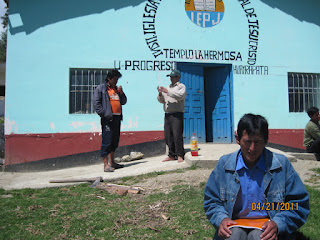A few years ago we were on a routine bus trip from Lima to Andahuaylas. It was night, the lights were out, and I was asleep. Suddenly a woman at the back of the bus screamed and started running up the aisle. With a thud she fainted, close to my seat. We called for the bus stewardess who put her in the vacant seat next to me. A passenger gave her coca leaves to chew. Another passenger suffered from paralysis and couldn't move his arms. When these two were revived, a British tourist, who had heard us speaking English, turned to us mournfully and said, "I think I'm going to die."
 |
| Those breathtaking views may come at a price. |
What had happened to them? They had gotten on the bus in Nazca, 588 meters above sea level, at suppertime. Now we were crossing the Andes through the pass Condorsencca which is 4330 meters (14, 206 feet) above sea level. (The route includes another pass a bit later, Occe Occe, which is 4400 meters (14,435 feet) above sea level. These are classified as very high altitudes, and the rapid ascent (over 2-1/2 miles in 5 hours) can make some people very ill.
The Princeton University webpage
Outdoor Action Guide to High Altitude describes a classic scenario for developing altitude sickness:
You fly from New York City to a Denver at 5,000 feet (1,525 meters). That afternoon you rent a car and drive up to the trailhead at 8,000 feet (2,438 meters). You hike up to your first camp at 9,000 feet (2,745 meters). The next day you hike up to 10,500 feet (3,048 meters). You begin to have a severe headache and feel nauseous and weak. If your condition worsens, you may begin to have difficulty hiking. Scenarios like this are not uncommon, so it's essential that you understand the physiological effects of high altitude.
Here in the city of Andahuaylas we are at 2926 meters (1.8 miles or 9,599 feet). Since most people can go up to 8,000 feet with no effect, we are just a little too high for some people. Unfortunately the only way to predict if you will be sick at high altitude is if you have been sick at high altitude before, which makes it interesting for visitors. However, most people with symptoms only need to wait a few days to get accustomed to the altitude.
When you leave Andahuaylas to visit the surrounding pueblos you almost always go up. Sometimes people who are fine in Andahuaylas are sick with headache and nausea from even a slight climb, such as to visit the archeologial site of Sondor. This is not usually the case, but in a group of 20, maybe one will be sick.
Another problem at the altitudes above Andahuaylas is that the climate is extreme. Brutally cold at night (below freezing, and they don't have heat in houses or hotels even in these locations) and with roasting hot sun during the day. Several times recently we have made overnight trips to Uripa, which is at 10,416 feet (3175 m.) The 1000 foot ascent plus the extremes of temperature have caused us to have headaches and stomach problems.
For those of you who are considering coming here, don't be discouraged by all this. But do plan ahead. Some measures that can help are:
- Drink plenty of water--about 2 liters a day.
- Plan a day of rest when you first arrive.
- If your trip is programmed for areas outside of Andahuaylas, plan to come back to sleep in Andahuaylas.
- Drink the coca tea. On the bus trip I described at the beginning, the coca leaves relieved the fainting, paralysis, and "going to die" symptoms within 10 minutes. The raw leaves are not a drug, and are perfectly legal in Peru and Bolivia. Only skip it if you are going to have a drug test on your arrival in the US.
- Wear a hat. This traditional Peruvian solution really helps.
- If you are really sick, get a prescription drug such as Diamox.
- Read up on information like the Princeton webpage.
A prudent person foresees danger and takes precautions. The simpleton goes blindly on and suffers the consequences. Proverbs 27:12 NLT























































